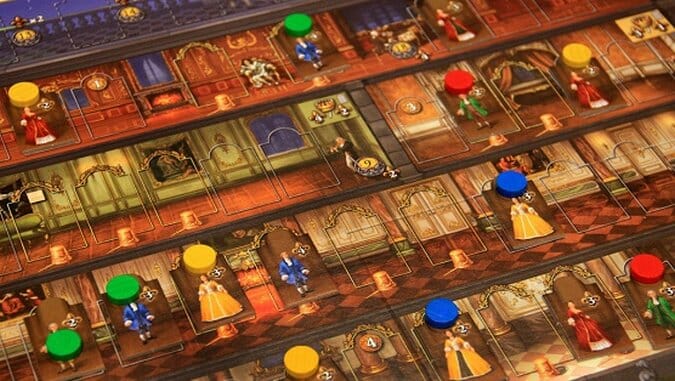Rococo Boardgame

Rococo was one of two runners-up to Istanbul for the 2014 Kennerspiel des Jahres prize, given to the best advanced or “connoisseur’s” game of the year, a complex strategy game that moves fairly quickly but has so many different ways to score that the handful of decisions players have are both involved and critical to the outcome.
Rococo’s theme is a new one in my experience: Players represent owners of dressmaking firms in 18th or 19th century Europe, starting with five employees apiece, and must collect the raw materials to make dresses and suits for partygoers, choosing either to sell them or to “rent” them by placing the completed tokens in one of the five halls on the board. Different employees can undertake different tasks, and each employee card has a second bonus action to be executed after the employee’s main action.
The three employee types are the Master, who can take any action; the Journeyman, who can do anything but hire another employee; and the Apprentice, who can only take fabric, “depute” an employee, or fund a decoration on the board. Players have six options for their main actions: buying one of nine (in a 2-3 player game) or twelve (in a 4-5 player game) fabric tiles from the warehouse on the board; making a dress, then selling or renting it; hiring one of the four employees available on the side of the board in that round; deputing one of his/her existing employees, taking a small fee in exchange for sending that employee to a better place; asking for the queen’s favor, making that player the start player in the next round while gaining a 5-coin bonus; or buying a decoration somewhere on the board, most of which are worth point bonuses at the end of the game, some significant.
Rococo has a deckbuilding element to it, even though player decks never get very fat. Each player starts the game with those five employee cards, and may add to it or delete from it as the game goes on. In any single turn, a player chooses (not draws) three cards from his/her unplayed deck to be his/her hand for that round. If the unplayed deck contains fewer than three cards, the player chooses cards from his discard pile to get his hand up to three cards. If the player uses a Master card to hire a new employee, that employee goes right into the player’s hand, so it’s possible to have four or even five cards (and thus turns) within a single round. That means players will get between 21 and maybe 25 turns in total for the entire game.
Once every player has used all of his/her cards for the round, each player receives a base income of 5 coins plus any bonuses tied to the Fountain decoration—some for having dresses placed on the board, some for decorations already purchased. In my experience playing Rococo, I found getting some source of increased income to be vital to competing.
-

-

-

-

-

-

-

-

-

-

-

-

-

-

-

-

-

-

-

-

-

-

-

-

-

-

-

-

-

-

-

-

-

-

-

-

-

-

-

-









































